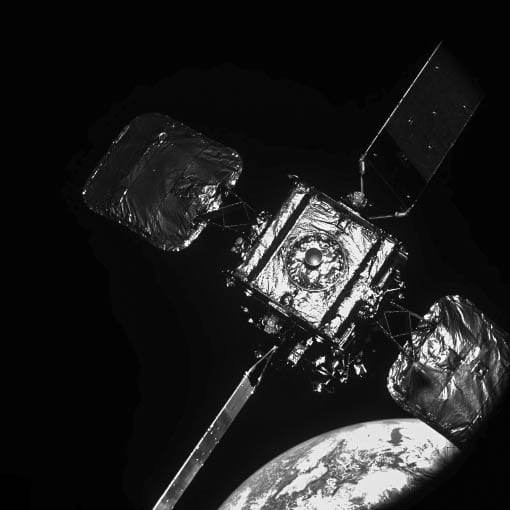Latest News
Northrop Grumman Successfully Docks Second Mission Extension Vehicle with Operational Intelsat Satellite

An image of the IS-10-02 satellite taken by the MEV-2 vehicle as it was approaching for docking in April 2021. Photo: Northrop Grumman
Northrop Grumman and its SpaceLogistics LLC subsidiary hit another milestone in the work to commercialize in-orbit satellite servicing on Monday, as the second Mission Extension Vehicle (MEV-2) successfully docked with Intelsat 10-02 (IS-10-02). This demonstration follows after the first Mission Extension Vehicle (MEV-1) made history docking with Intelsat 901 in February 2020, as the first time two commercial satellites were docked in space.
But this docking was different in one key way. MEV-1 docked with IS-901 above Geostationary Orbit (GEO) in a graveyard orbit, before moving the satellite back into service — while MEV-2 was docked with IS-10-02 directly in its GEO operational location.
SpaceLogistics Vice President Joe Anderson said this docking was not necessarily more technically challenging, but Northrop Grumman took caution with calibration approaches ahead of the docking.
“From a customer point of view it is a totally different ballgame,” said Jean-Luc Froeliger, Intelsat’s vice president of Space Systems Engineering and Operations. “We have customers carrying live traffic, we don’t want to disrupt them. So you have to be extremely careful in every approach that you do that you don’t put your services in danger. Docking on a satellite carrying live traffic is a different level of complexity. You have to be extremely prudent with your approach and Northrop Grumman did a great job.”
Froeliger said that only minor degradation of the Radio Frequency (RF) performance of the satellite was observed, and none of IS-10-02 customers, including main customer Telenor Satellite, experienced disruption.
Both spacecraft are operational and healthy. MEV-2 will now provide five years of service to the Intelsat satellite before undocking and moving on to provide services for a new mission. Tom Wilson, vice president of Northrop Grumman and president of SpaceLogistics, said that MEV-1 and MEV-2 are not yet contracted beyond the primary five-year periods because the company wanted to prove the technology before signing other customers.
Froeliger said this mission extends the lifetime of IS-10-02, which is 17 years old and in “pristine health,” except for the fact that it was running out of fuel. The satellite offers broadband and media distribution services for customers across Europe, Middle East, Africa and the Americas.
“In-orbit servicing is a win-win for us at Intelsat,” Froeliger said. “It helps us realize greater value for our otherwise healthy and high-performing satellite, while at the same time, focusing our capital expenditure on next generation technology like the software-defined satellites procured earlier this year.”
Northrop Grumman is also in production of second generation systems to introduce in-orbit, robotic servicing capabilities, which are scheduled for launch in 2024. The Mission Robotic Vehicle (MRV) can install a Mission Extension Pod (MEP) onto a client vehicle. The Mission Extension Pod is a propulsion-augmentation device that can provide six years of station keeping propulsion to a typical GEO satellite One MRV can install five to six of these extension pods each year, Anderson said.
He also mentioned future applications for the technology including debris removal in orbit, and satellite servicing in Low-Earth Orbit (LEO).
Northrop Grumman and subsidiary SpaceLogistics LLC were recognized by Via Satellite earlier this month for in-orbit servicing technology. The MEV-1 mission won Satellite Technology of the Year. Accepting the award on April 5, Anderson said this mission “feels like our industry is crossing a threshold into Space 2.0, where satellite servicing becomes commonplace.”
Stay connected and get ahead with the leading source of industry intel!
Subscribe Now